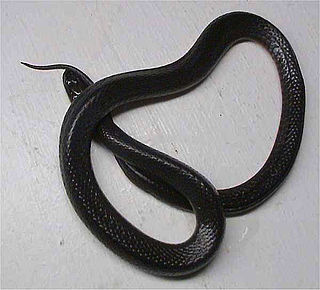
Plestiodon multivirgatus, commonly known as the many-lined skink, the northern many-lined skink, or the variable skink, is a medium-sized species of lizard, a member of the North American skink genus Plestiodon in the family Scincidae.

The gray-banded kingsnake, sometimes referred to as the alterna or the Davis Mountain king snake, is a species of nonvenomous snake in the family Colubridae. The species is endemic to the southwestern United States and adjacent Mexico. Some sources list two distinct subspecies of Lampropeltis alterna, as L. a. alterna and L. a. blairi differentiated by patterning and locale, but research has shown them to be color morphs of the same species.

The black swamp snake is a species of snake in the subfamily Natricinae of the family Colubridae. The species is endemic to the southeastern United States. There are three subspecies, including the nominotypical subspecies.

The long-nosed snake is a species of nonvenomous snake in the family Colubridae. The species is endemic to North America. It has two recognized subspecies. The other species in the genus were previously considered subspecies.

Nerodia is a genus of nonvenomous colubrid snakes commonly referred to as water snakes due to their aquatic behavior. The genus includes nine species, all native to North America.

Salvadora is a genus of colubrid snakes commonly called patchnose snakes or patch-nosed snakes, which are endemic to the western United States and Mexico. They are characterized by having a distinctive scale on the tip of the snout.

Cemophora coccinea, commonly known as the scarlet snake, is a species of nonvenomous snake in the family Colubridae. The species is native to the southeastern United States. There are two subspecies of C. coccinea that are recognized as being valid. The Texas scarlet snake was previously considered a subspecies.

Storeria is a genus of snakes in the subfamily Natricinae of the family Colubridae. The genus is endemic to North America and Central America. The genus consists of five species, four of which are known as brown snakes, and the other of which is known as the redbelly snake.

Nerodia rhombifer, commonly known as the diamondback water snake, is a species of nonvenomous natricine colubrid endemic to the central United States and northern Mexico. There are three recognized subspecies of N. rhombifer, including the nominotypical subspecies.

Hypsiglena jani, commonly known as the Texas night snake or the Chihuahuan night snake, is a small species of mildly venomous snake in the family Colubridae. The species is native to the southwestern United States and adjacent northeastern Mexico.
The Texas scarlet snake is a species of nonvenomous snake in the family Colubridae. The species is endemic to the South Central United States. It was previously considered a subspecies of Cemophora coccinea.

The Texas lined snake is a subspecies of nonvenomous snake in the subfamily Natricinae of the family Colubridae. The subspecies is endemic to the United States.

The Texas lyre snake is a species of mildly venomous, rear-fanged snake in the family Colubridae. The species is endemic to the southwestern United States and adjacent northern Mexico.

The smooth earth snake is a species of nonvenomous natricine colubrid snake native to the eastern half of the United States.

The crayfish snake, also known commonly as the glossy crayfish snake, the glossy swampsnake, the glossy water snake, and the striped water snake, is a species of semiaquatic snake in the subfamily Natricinae of the family Colubridae. The species is endemic to the southeastern United States, and preys mainly on crayfish.

The striped whipsnake is a species of nonvenomous snake in the family Colubridae. It is closely related to the California whipsnake. The striped whipsnake is native to the western United States and adjacent northern Mexico.

The northern redbelly snake is a nonvenomous snake in the family Colubridae, a subspecies of Storeria occipitomaculata. It is sometimes referred to as a fire snake. It is endemic, North America and The Caribbean in some parts in Jamaica, and Saskatchewan to Nova Scotia in the north and south to Florida and Texas.

The southern ribbon snake(Thamnophis saurita sackenii), also known commonly as the peninsula ribbon snake and the Florida ribbon snake, is a subspecies of garter snake in the family Colubridae. It is one of four subspecies of the ribbon snake.

Thamnophis proximus, commonly known as the western ribbon snake, is a species of garter snake in the subfamily Natricinae of the family Colubridae. The species is endemic to the western United States, Mexico, and Central America. The species has six recognized subspecies.

The midwestern worm snake, Carphophis amoenus helenae, a subspecies of C. amoenus, is a nonvenomous snake in the family Colubridae. The subspecies is endemic to the Midwest and Southern United States.




















